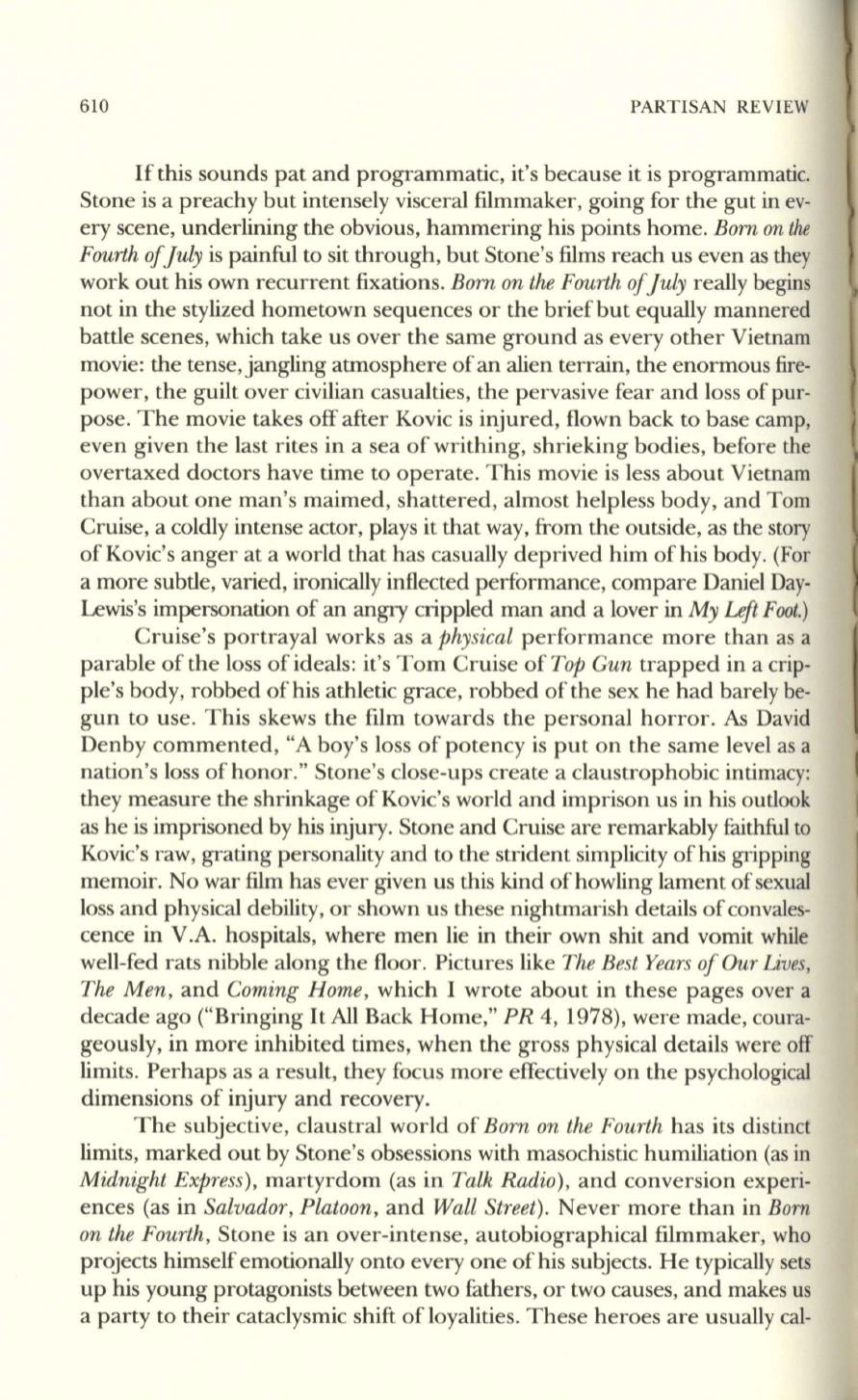
610
PARTISAN REVIEW
If
this sounds pat and programmatic, it's because it is programmatic.
Stone is a preachy but intensely visceral filmmaker, going for the gut in ev–
ery scene, underlining the obvious, hammering his points home.
Born on the
Fourth ofJuly
is painful to sit through, but Stone's films reach us even as they
work out his own recurrent fixations.
Born on the Fourth ofJuly
really begins
not in the stylized hometown sequences or the brief but equally mannered
battle scenes, which take us over the same ground as every other Vietnam
movie: the tense, jangling atmosphere of an alien terrain, the enormous fire–
power, the guilt over civilian casualties, the pervasive fear and loss of pur–
pose. The movie takes off after Kovic is injured, flown back to base camp,
even given the last rites in a sea of writhing, shrieking bodies, before the
overtaxed doctors have time to operate. This movie is less about Vietnam
than about one man's maimed, shattered, almost helpless body, and Tom
Cruise, a coldly intense actor, plays it that way, from the outside, as the story
of Kovic's anger at a world that has casually deprived him of his body. (For
a more subtle, varied, ironically inflected performance, compare Daniel Day–
Lewis's impersonation of an angry crippled man and a lover in
My
Left
Foot.)
Cruise's portrayal works as a
physical
performance more than as a
parable of the loss of ideals: it's Tom Cruise of
Top Gun
trapped in a crip–
ple's body, robbed of his athletic grace, robbed of the sex he had barely be–
gun to use. This skews the film towards the personal horror.
As
David
Denby commented, "A boy's loss of potency is put on the same level as a
nation's loss of honor." Stone's close-ups create a claustrophobic intimacy:
they measure the shrinkage of Kovic's world and imprison us in his outlook
as he is imprisoned by his injury. Stone and Cruise are remarkably faithful to
Kovic's raw, grating personality and to the strident simplicity of his gripping
memoir. No war film has ever given us this kind of howling lament of sexual
loss and physical debility, or shown us these nightmarish details of convales–
cence in V.A. hospitals, where men lie in their own shit and vomit while
well-fed rats nibble along the floor. Pictures like
The Best Years of Our Lives,
The Men,
and
Coming Home,
which I wrote about in these pages over a
decade ago ("Bringing
It
All Back Home,"
PR
4, 1978), were made, coura–
geously, in more inhibited times, when the gross physical details were off
limits. Perhaps as a result, they focus more effectively on the psychological
dimensions of injury and recovery.
The subjective, claustral world of
Born on the Fourth
has its distinct
limits, marked out by Stone's obsessions with masochistic humiliation (as in
Midnight Express),
martyrdom (as in
Talk Radio),
and conversion experi–
ences (as in
Salvador, Platoon,
and
Wall Street).
Never more than in
Born
on the Fourth,
Stone is an over-intense, autobiographical filmmaker, who
projects himself emotionally onto everyone of his subjects. He typically sets
up his young protagonists between two fathers, or two causes, and makes us
a party to their cataclysmic shift of loyalities. These heroes are usually cal-


